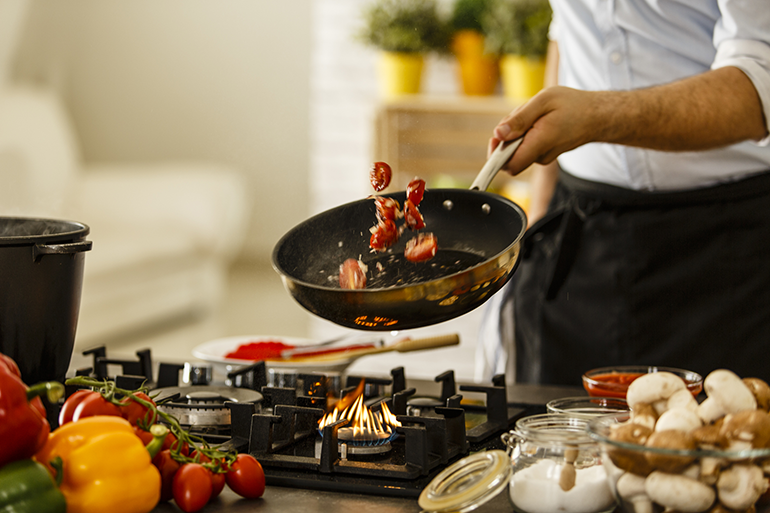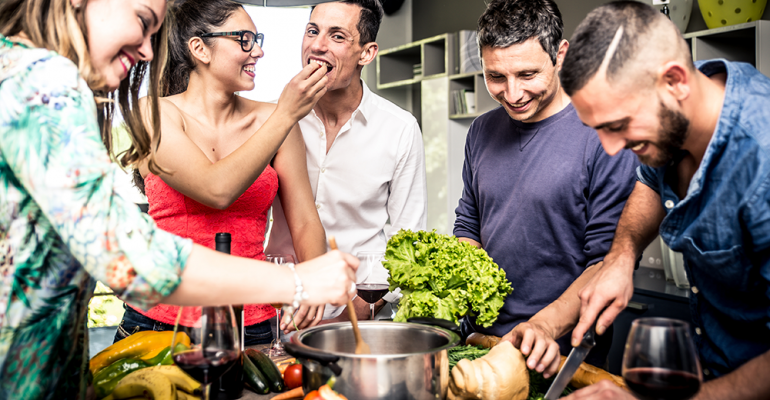In Part 1 of this column, marketing experts addressed the question, ‘Could cooking at home go from necessity to hobby?’
But if we back up a bit, we have to admit that all these conversations about whether or not people enjoy cooking depend greatly upon how we even define that word. In a world of conveniences, what is cooking?
Is it cooking if you use a can of soup as an ingredient? Does cooking from a kit that arrives on your doorstep count — after all, there’s usually quite a bit of prep involved in those meal delivery kits. If you shed a tear chopping an onion, did you cook?
While one might expect that older respondents to our survey would be the traditionalists, we actually found the opposite. In fact, it was 18-to 24-year-olds who considered cooking to be scratch cooking — 45.5% said they define “cooking” as the kind of food preparation that uses flour and eggs. By comparison, 45% of those over the age of 25 defined cooking as using both fresh ingredients and prepared foods such as bottled sauce or canned soup.
Kim Bartley, CMO of White Castle — a regional quick-service chain that’s also well represented in the frozen food aisle of grocery stores nationwide — wasn’t surprised by the changing definitions of what cooking is.
“There’s a blurring of everything,” she said. “It makes the definition of what is cooking and what is fresh very interesting. If you think about it, it’s like the difference between what a ‘friend’ is before and after Facebook.”
“There’s so much blurring, the consumer doesn’t look at it through these different lenses anymore. We’ve given them so many options. So to me, one of the things I look at is to find out what these tipping points have been in food.”
“The first major change was working moms entering the market,” Bartley said, which shifted not just how much time women spend cooking but also added more health-based options to restaurants beginning in the 1970s and ‘80s.

Eating in an on-demand world
Today’s shifts are different and are largely driven by how consumers buy. It all comes down to the “Amazon-ization” of the entire consumer experience.
“What Amazon did was give everyone the appetite to have whatever they wanted no matter how niche it was — and they want it right away,” Bartley said.
The total infiltration of instant gratification and on-demand shopping experiences is upending branding and marketing across industries. When it comes to grocery shopping, the ease with which consumers, from busy Millennial cooks to Boomers with growing mobility concerns, can simply swipe to purchase exactly what they’ve purchased in the past is certainly turning shopper marketing on its head. It’s a sea change in consumer attitudes.
“Today, experience, more than communications, drives how consumers perceive brands. Customization is at the core of most shopping experiences. And everything happens not just fast, but immediately,” said Lindsay Ferris of Lindsay, Stone & Briggs. “It’s not just grocery stores feeling these changes. Communication, media, healthcare, education … every category is adjusting to shifting expectations.”
What does all this mean for you as a food marketer?
It means three things: First, brand matters, even in an Amazon world. It’s more important than ever to uncover the real consumer motivations that drive purchase. Second, brand design is critical. Traditional design for food brands focused on how the product looked on the shelf, but the focus needs to shift to how the product and brand will look on the screen.
And finally, “it’s more important to truly understand the consumer path to purchase and how emotion plays in every step of the purchase journey,” Ferris said.
As Reggie Moore, senior VP of sales and marketing for Land O’Frost, said in Meatingplace, “it’s about how you create a deeper, stronger relationship with consumers. Specifically being consumer-centric, keeping a pulse on changing psychographics, and the rapidity of change.”
And with all these shifts and the rapid pace of consumer impulses turning into consumer decisions, marketers must be nimble and data-driven. A process of continuous test-and-learn tempered by rigorous measurement and course correction should be at the center of any strategy.
As tired as the phrase may be, we might be able to say that we’re in the middle of a paradigm shift when it comes to cooking.
Freed from the need to cook — for cost, health, convenience or other reasons — consumers are choosing not to shop or cook in traditional ways. But brands still play an important role —less as a package sitting on a store shelf and more as a solution available on demand.
Can food brands adapt to this new model? Some may not, but those who are willing to experiment, learn and lean into the new reality, certainly will.
Survey details:
Survey conducted using Pollfish, with 1,000 total responses. Respondents were restricted to residents of the U.S., and ranged from 14-17 (0.8% of total respondents) to > 54 (6.5% of total respondents). Respondents were 57% female, 43% male. Highest education levels attained ranged from middle school (3.5% of respondents) to post-graduate (6.5% of total respondents) with the largest cohort listing high school (53.8%). The highest representation of income levels were in the Lower 1 tier (37.2%) and Lower II (28.6%) tiers.
About the author:
Eleanor “Ellie” Pierce is a recovering journalist, Pacific Northwest expat, and director of content strategy for Lindsay, Stone & Briggs, a full-service ad agency and marketing consultancy with offices in Madison, Wis., and Minneapolis.





